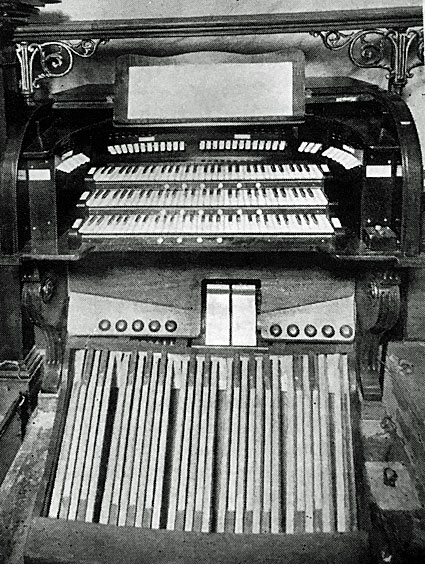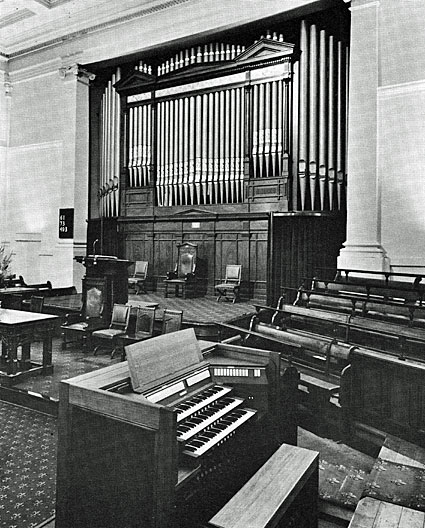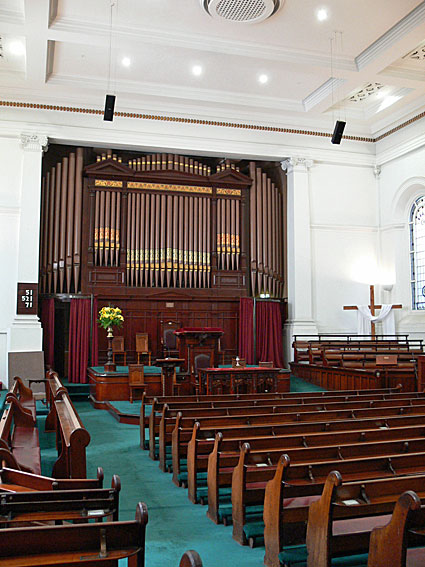
Baptist Church, Collins Street: exterior
[photograph by John Maidment (30 November 2016)]

Baptist Church, Collins Street: exterior
[photograph by John Maidment (30 November 2016)]
Historical and Technical Documentation by John Maidment
© OHTA, 2016 (latest update December 2016)
The original section of the present building dates from as early as 1845, designed by John Gill, and the Corinthian style façade was added in 1861 to the design of Reed & Barnes.1 It is a rare example of a Melbourne church designed in the classical style with a massive portico.

Baptist Church, Collins Street: interior looking to the rear and the Hamlin organ
[Collins Street Baptist Church Dedication and Opening of Rebuilt Organ 4 July 1976]
The first organ was placed in the rear gallery of the church and opened on 1 June 1859. The builder, Hamlin & Son, of 8 Brook Street, Euston Road, London, also built a two-manual chamber organ, now in St Paul's Anglican Church, Clunes.
The opening of the organ was reported as follows:
The opening of the new organ at the Baptist Chapel, in Collins-street, took place yesterday evening. The instrument is constructed by Messrs. Hamlin and Son-whose name, by the way, we had never previously heard mentioned as having built any organ of note-and is of two uniform rows of keys, with two and a half octaves of pedals; the scale and disposition of the parts being those of the old-established German system, professionally distinguished in England by the term "C." The great organ contains the following stops :-Open diapason 8 feet;, stop diapason; clarabella, marked 8 feet, sounding 4 only ; viol de gamba, marked 8 foot, sounding 4 only; principal (4 feet); fifteenth (2 foot) ; and sexquialtra. Tho swell organ to tenor C contains : - Dulciana (4 feet) ; stop diapason (4 foot) ; principal ; cornopean ; and hautboy. There are two couplers, joining the swell to the great organ, and pedals to the same; also three composition pedals. Economy evidently appears to have been the ruling point in the construction of the instrument; for in reality, only a few of these stops extend throughout the entire register, and the pedal pipes do not actually sound more than one octave. The quality of the instrument is not the most refined, and the tone is somewhat uneven; the reed stops in the swell are deficient in finish, and harsh in tone. Mr. Pringle, who officiated as organist on the occasion, was prejudiced by his performance on an instrument, not only out of tune, but badly constructed.2
In 1885 this organ was replaced by a new organ built by Alfred Fuller, of Kew. The Hamlin organ appears to have been acquired by William Anderson, who carried out changes before it was installed at the Wesleyan Church, Clifton Hill in 1890. The organ remained there until the 1960s when it was removed by Hill, Norman & Beard (whose factory was around the corner). Pipework was used to augment the Fincham organ in the Methodist Church, Highbury Grove, Canterbury. The casework (thought to be of mahogany, and of an elegant classical design) remained in the HN&B factory until 1969 when it was presumably destroyed, room being necessary to store the 1890 Fincham organ from the former Methodist Mission in Brunswick Street, Fitzroy.

Baptist Church, Collins Street: interior showing the Alfred Fuller organ 1936
[Collins Street Baptist Church Dedication and Opening of Rebuilt Organ 4 July 1976]
A new organ, built by Alfred Fuller, the Kew organbuilder, was opened in 1885. The Fuller organ was placed in an apse at the front of the building, behind a striking classical case with splendidly decorated façade pipes. The decoration of the organ was fully described in the press:
A good specimen of simple but effective decorative art, as applied to the most striking feature of an ecclesiastical interior, is to be seen in the new organ and appurtenances of the Baptist Church, Collins street. The object of the artist, Mr Robert Reid, has been to join the instrument as it were, on to the internal fittings of the edifice, instead of allowing it to remain a highly coloured excrescence standing out obtrusively from bare walls. He has accomplished his purpose by carrying the prevailing hue of the brown wood work of the pews into the framing of the organ, gradually enriching this with ornament until the tubes of the organ are reached. The colours employed upon these are pure scarlet lake and ultramarine blue, put on as a glaze and not solid. The wood itself has been treated with a transparent stain, varying in depth, so as to emphasise matters of structural detail. All the forms used are pure Byzantine and the same remark applies to the colours and ornaments.3
The Fuller organ was opened on 13 August 1885:
A new organ, built by Mr. Fuller, of Kew, was opened last evening in the Collins-street Baptist Church by Mr. Philip Plaisted, who played a triumphal march, by Prout; two andantes, by Batiste; the Sicilian's Mariner's Hymn, with variations, by Lux; the adagio from Haydn's Symphony in C; The Storrn Fantasia, by special request; and Bach's prelude and fugue on St. Ann's tune. All of these selections were given in a masterly manner, and showed the capabilities of the instrument to great advantage. The organ consists of three manuals, the great having nine stops, the swell eleven, the solo seven and the pedal five, making in all thirty-nine, the number of pipes contained in the instrument being 1918. The stops are of excellent quality, and the organ does great credit to the builder. Mr. Plaisted was assisted by Miss Jobson, Mr. Moroney and the members of the church choir.4
A second press account indicated that the organ was designed by Philip Plaisted:
There was a very large attendance at the Baptist Church, Collins-street, on Thursday, upon the occasion of the opening of the new organ in that church, built by Mr. Alfred Fuller, of Kew, from specifications supplied by Mr. Philip Plaisted. The organ consists of three manuals and pedal, and contains the following stops and pipes. Great organ, 9 stops 616 pipes ; swell, 11 stops 784 pipes: solo, 7 stops 368 pipes; pedal, 5 stops 150 pipes; couplers, &c., 7 stops; grand totals 39 stops and 1,918 pipes.5
Another account gave further detail, also indicating that the drawstop faces were coloured to distinguish the various departments in the organ, a surviving label from the 1891 Fuller organ formerly in the Congregational Church, Kew having a crimson face.
There was a very large attendance at the Baptist Church, Collins-street, last night, upon the occasion of the opening of the new organ in that church, built by Mr Alfred Fuller, of Kew, from specifications supplied by Mr. Philip Plaisted. The organ consists of three manuals and pedal and contains the following stops and pipes: - Great organ, 9 stops, 616 pipes; swell, 11 stops 784 pipes; solo, 7 stops, 368 pipes; pedal, 5 stops 150 pipes; couplers, &c, 7 stops, grand totals, 39 stops and 1,918 pipes. The stops referring to the different organs are grouped in colours for distinction. The wind is supplied by large feeders, worked by an hydraulic engine placed beneath the instrument, and is under complete control of the performer, for whose convenience a wind indicator is always in sight. The artistic decorations by Mr. Robert Reid of the front pipes and the case (the latter of which was designed by the architects, Messrs Reed Henderson, and Smart) have been already described in The Argus. A lengthy programme had been arranged for last evening Mr. Philip Plaisted was organist. The church choir gave several anthems, and Mr. B.T. Moroney and Miss Florence Jobson contributed solos and sacred songs. When the programme had been partly gone through, the Rev. S. Chapman gave a short address, in which he thanked the congregation for their fall attendance and asked for support to the organ fund, a collection in aid of which was then made. The organ will cost about £1,200.6
The specification of the Fuller organ was recorded as follows7:
| GREAT Open Diapason Gamba Stopped Diapason Principal Wald Flute Nazard Fifteenth Sesquialtera Trumpet |
8 8 8 4 4 2-2/3 2 III 8 |
|||
| SWELL Lieblich Bourdon Violin Diapason Lieblich Gedackt Geigen Principal Harmonic Piccolo Twelfth & Fifteenth Mixture IV Horn Oboe Clarion |
16 8 8 4 2 3 & 2 II IV 8 8 4 |
|||
| SOLO (enclosed) Harmonic Flute Salicional Voix Celeste Concert Flute Flageolette Bassoon & Clarionet Vox Humana |
8 8 8 4 2 8 8 |
[gvd bass] TC |
||
| PEDAL Open Diapason Bourdon Quint Violoncello Bass Flute |
16 16 10-2/3 8 8 |
In 1908, Geo.Fincham & Son made some tonal changes. The Great Nazard 2-2/3 was lengthened to form a Dulciana 8 and the Swell Mixture 4 ranks was removed and replaced with a Viol d'Orchestre 8.8

Baptist Church, Collins Street: the W.L. Roberts console 1939
[Collins Street Baptist Church Dedication and Opening of New Organ April 1939]
The organ was rebuilt by Adelaide organbuilder W.L. Roberts, job no 151a, costing £750. This comprised new electro-pneumatic action, a new stopkey console (but retaining the Fuller sides, roll top and carved brackets), and the addition of a Hohl Flute 8 and Rohr Flute 4 to the Swell, most likely through substitution for earlier Fuller ranks. It was reopened on 25 April 1939.9 The manual compass was extended from 56 to 61 notes.
In 1957, Geo.Fincham & Sons Pty Ltd added an Open Diapason unit of 85 pipes to the Great and Pedal Organs in memory of the late Judge Book, a member of the church for over 40 years.10 The pipes had come from the dismantled three-manual Fincham organ in St Mary's Mission, Fitzroy Street, Fitzroy, removed in 1956, the longest 19ft 6 inches long with a diameter of 10 inches.11
The specification of the organ after the Roberts rebuild and the Fincham additions was as follows12:
| GREAT Double Diapason Open Diapason Open Diapason Open Diapason Stopped Diapason Dulciana Octave Principal Wald Flute Fifteenth Mixture Trumpet |
16 8 8 8 8 8 4 4 4 2 III 8 |
A A old Gamba A |
||
| SWELL Lieblich Bourdon Violin Diapason Hohl Flute Geigen Principal Rohr Flute Harmonic Piccolo Mixture 12.15 Horn Oboe Clarion |
16 8 8 4 4 2 II 8 8 4 |
|||
| CHOIR (enclosed) Concert Flute Salicional Voix Celeste Harmonic Flute Flageolet Clarionet Vox Humana |
8 8 8 4 2 8 8 |
TC |
||
| PEDAL Open Diapason Open Diapason Sub Bass Quint Bass Cello Bass Flute |
16 16 16 16 8 8 |
A [sic] |

Baptist Church, Collins Street: the rebuilt organ and new detached stopkey console
[Collins Street Baptist Church Dedication and Opening of Rebuilt Organ 4 July 1976]
This organ was rebuilt by Laurie Pipe Organs Pty Ltd in consultation with George Moore. The dedication and opening recital by Lindsay O'Neill took place on 4 July 1976. The work included extensive tonal revision, new chorus reeds, electro-pneumatic action and a detached stopkey console.
| GREAT Bourdon Open Diapason no 1 Open Diapason no 2 Stopped Diapason Principal Stopped Flute Twelfth Fifteenth Tierce Mixture 19.22.26 Trumpet Swell to Great Choir to Great |
16 8 8 8 4 4 2-2/3 2 1-3/5 III 8 |
A former Pedal Quint extended existing Open no 3 converted back from Dulciana (Fuller Nazard) TC existing Mixture rank 1 new new |
||
| SWELL Lieblich Bourdon Open Diapason Wald Flute Salicional Voix Celeste Principal Rohr Flute Nazard Fifteenth Mixture 19.22 Sharp Mixture 26.29 Double Trumpet Trumpet Oboe Clarion Tremulant Swell Octave |
16 8 8 8 8 4 4 2-2/3 2 II II 16 8 8 4 |
Choir Flute 4 with new bass Choir, with new bass TC transposed and revoiced existing revoiced new new B B new B |
||
| CHOIR Stopped Diapason Dulciana Principal Flageolet Larigot Mixture 22.26 Clarinet Tremulant Tromba Magna Choir Octave Swell to Choir |
8 8 4 2 1-1/3 II 8 8 |
(enclosed except Tromba) new new former Gt Open no 2 new new C new |
||
| PEDAL Open Wood Open Metal Subbass Bourdon Quint Principal Flute Fifteenth Sesquialtera 19.24 Trombone Double Trumpet Tromba Clarion Great to Pedal Swell to Pedal Choir to Pedal |
16 16 16 16 10-2/3 8 8 4 II 16 16 8 4 |
D E A former Pedal Flute and Quint F former Cello E F part old C B C C |
Compass: 61/30
Adjustable thumb and toe pistons
Electro-pneumatic action
WIND PRESSURES
Great 90mm
Swell 115mm
Choir 90 mm
Pedal 125mm
Tromba/Trombone 150mm13
1 Victorian Churches, edited by Miles Lewis. East Melbourne: National Trust of Australia (Victoria), 1991, p.46
2 Argus, 2 June 1859, p.4
3 Argus, 6 August 1885, p.6
4 Age, 14 August 1885, p.5
5 Australasian, 15 August 1885, p.27
6 Argus, 14 August 1885, p.4
7 George Fincham letters 5/3-4; Bob Jefferson, Steve Laurie, Organ Builder: His Life and Works. Somers, Vic.: the author, 1998, p.158.
8 George Fincham letters 22/92, cited in E.N. Matthews, Colonial Organs and Organbuilders. Carlton: Melbourne University Press, 1969, p.108
9 Details from W.L. Roberts order book, courtesy of David Shield
10 Church Notes, March 1957, nop.445
11 Ibid
12 Specification from Dedication and Opening of New Organ, April 1939 and notes by John Maidment
13 Specification from Collins Street Baptist Church; Dedication and Opening of Rebuilt Organ Sunday July 4th 1976 and notes by John Maidment

Baptist Church, Collins Street: interior showing the rebuilt organ with the Judge Book Diapason pipes
[photograph by John Maidment (12 February 2009)]